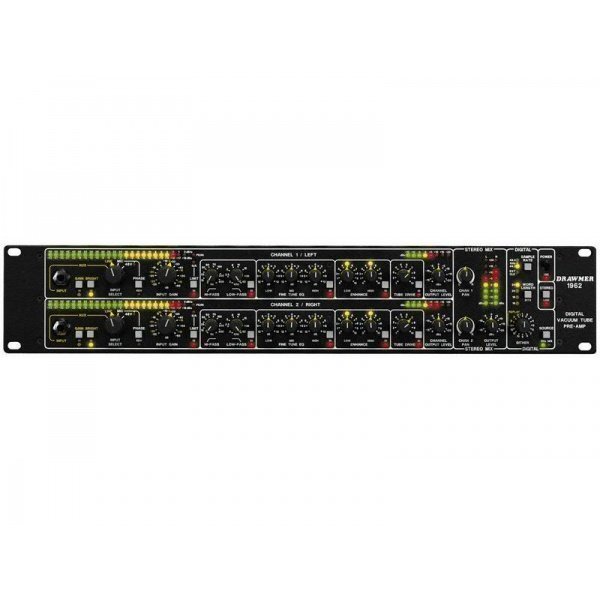Drawmer 1962 TDIF

Product Information
The wide dynamic range of high-resolution digital recording has remained largely unexploited simply because pre-amplifier technology cannot deliver an equivalent dynamic range. More significantly, limited headroom pre-amplifiers may also degrade or "squash" the dynamic range of the sound source, en-route to the recording medium.
From the silence of the noise floor to the onset of clipping, the Drawmer 1962 provides an input dynamic range of more than 133dB, eclipsing the performance of other front-end devices and coming close to theoretical perfection.
A minimal signal path connects a matched pair of pre-amps directly to the high resolution 24-bit A/D converters. Further innovative processing circuitry including Drawmer's two-band Dynamic Spectral Enhancement (DSE), Fine-Tune EQ, Tube Drive and Transparent Limiting can be inserted in the signal path for creative applications. In addition, the 1962 uses Drawmer's digital 'bit-splicing' techniques to facilitate 24-bit recording on the Tascam and Alesis ADAT 16-bit digital multitrack machines.
The Drawmer 1962 is the 'one-box solution' for committing audio directly to the digital domain. For further application information please click here.
Controls
Input Meter: A huge 24 segment 'digitally scaled' LED bargraph meter gives accurate input level information. An additional red 'Peak' LED warns of clipping.
Auxiliary Input: An auxiliary input is provided for the 'direct injection' of instruments. In addition to the variable gain control (-25dB to +15dB) a Gain switch adds a further 20dB boost and a Bright switch gives a 'presence' peak to simulate the voicing of a typical guitar amplifier.
Limiter: A switchable 'zero overshoot' transparent limiter enables the full dynamic range of the signal to be utilised without fear of digital overload. A red LED illuminates when gain reduction takes place.
Input Select: This four position rotary switch selects the audio input source, which can be Mic, Mic with 48V phantom power, Line or Aux. The Line and Mic inputs are via rear-panel XLRs while the Aux input jack is located on the front panel. A red LED illuminates when the phantom power option has been selected. A Phase Reverse switch is applicable to both mic positions.
Input Gain: Situated directly below the input level bargraph meter, the Input Gain control provides from -25dB to +60dB of 'clean gain' for both mic settings and from -25dB to +20dB gain for Line and Aux inputs.
Variable High/Low Pass Filters: A fully variable high pass (15Hz - 400Hz) and low pass (2kHz - 42kHz) are provided for the removal of low frequency 'rumble' or high frequency 'hiss.' The filters are also useful for tailoring the bandwidth of individual signals within a mix.
Fine Tune EQ: Three bands of 'Fine Tune' equalisation are provided and are designed for audio sweetening rather than radical signal re-shaping. Low provides up to 12dB cut or boost with a gentle 6dB per octave shelving filter for 'fattening' whilst Mid is a 6dB per octave band-pass control designed to emphasise 'presence.' High is also a 6dB per octave shelving filter providing up to 12dB cut or boost to add a high frequency 'gloss' or moderate excessive brightness.
Dynamic Spectral Enhancement (DSE): Drawmer's proprietary DSE includes advanced circuitry and is designed to enhance transient detail by dynamically controlling the phase and spectral content of the programme material. Two variable controls are provided to add 'warmth' and 'sparkle.' Low Enhance is level dependant and emphasises low frequency harmonics according to the dynamic nature of the material. High Enhance increases the harmonic energy in high frequency transient signals. LED's above the Low/High controls show enhancement activity.
Tube Drive: This section contains a specially designed tube circuit with variable drive which emulates the classic tube sound for microphone or line input sources. When engaged this section inserts two dual-stage valves into the audio signal path allowing the user to add the desired amount of tube coloration.
Channel Output Level: Controls the channel's analogue output level with a variable gain range from -15dB to +20dB displayed by an eight segment LED meter. Adjustment of this control has no effect on the signal sent for digital conversion.
Stereo Mix: In this section separate Pan controls are provided for each of the two channels enabling the user to reduce the width of a stereo pair of microphones or re-position individual signals within a stereo mix.
A single stereo analogue output level is provided with Left/Right eight segment LED bargraph metering. To expand the flexibility of the 1962 further, up to three mix signals from other Drawmer 1962's or comparable line level stereo sources may be mixed in with the channel signals via the rear panel Stereo Mix inputs.
Limit: A switchable 'zero overshoot' transparent limiter enables the full dynamic range of the signal to be utilised without fear of digital overload. A red LED illuminates when gain reduction takes place.
Digital
▪ Sample Rate: This selects 48.0kHz, 44.1kHz or EXTERNAL CLOCK for synchronising to other digital devices.
▪ Word Length: The standard D62/T provides 16-, 18-, 20- or 24- bit Word Length (bit resolution) with AES/EBU, SPDIF and Tascam?
▪ TDIF-1 digital outputs. The optional D62/A provides the Alesis ADAT? optical interface.
▪ Dither: This switch provides a choice of 11 types of noise shaping (position12 is Dither-off). Positions A, B, C and D are modes for high-resolution recordings from digital recorders.
▪ Source: When Chs is selected channels 1 and 2 are sent directly for A/D conversion. MIX inserts the channel PAN controls into the signal path and enables up to three other stereo analogue signals, via rear panel inputs, to be mixed with channels 1 and 2 before A/D conversion.
- Shop
- Live sound and Studio
- Signal processing
- Drawmer 1962 TDIF
